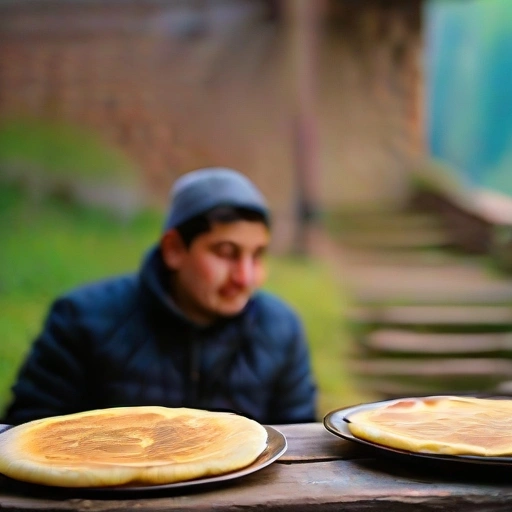Mchadi
Mchadi Recipe - Traditional Corn Flour Dish from Georgia
Introduction

Mchadi is a traditional Georgian cornbread that is simple to make and delicious to eat. This recipe has been passed down through generations and is a staple in Georgian cuisine.
History
Mchadi has been a part of Georgian cuisine for centuries, with its origins dating back to the times when corn was introduced to the region. It was a popular food among farmers and shepherds due to its simplicity and ability to provide sustenance during long days of work.
Ingredients
- 300 g of corn flour
- 300 g of water
How to prepare
- Combine flour and water in a bowl and knead the mixture to form a dough.
- Shape the dough into small round flat cakes and bake them in a preheated oven.
Variations
- You can add chopped herbs, cheese, or even chili flakes to the dough for different flavor variations.
Cooking Tips & Tricks
Make sure to knead the dough well to ensure a smooth texture.
- Preheat the oven before baking the mchadi to ensure even cooking.
- You can add herbs or cheese to the dough for extra flavor.
Serving Suggestions
Mchadi is best served warm with a dollop of butter or cheese on top.
Cooking Techniques
Baking is the traditional method of cooking mchadi, but you can also pan-fry them for a crispy texture.
Ingredient Substitutions
You can use wheat flour instead of corn flour if you prefer a different taste and texture.
Make Ahead Tips
You can prepare the dough ahead of time and refrigerate it until ready to bake.
Presentation Ideas
Serve mchadi on a wooden platter with a sprinkle of fresh herbs for a rustic presentation.
Pairing Recommendations
Mchadi pairs well with Georgian dishes such as khachapuri or grilled meats.
Storage and Reheating Instructions
Store leftover mchadi in an airtight container at room temperature. Reheat in the oven or microwave before serving.
Nutrition Information
Calories per serving
Each serving of mchadi contains approximately 150 calories.
Carbohydrates
Each serving of mchadi contains approximately 30g of carbohydrates.
Fats
Each serving of mchadi contains approximately 2g of fats.
Proteins
Each serving of mchadi contains approximately 4g of proteins.
Vitamins and minerals
Mchadi is a good source of vitamin A and iron.
Alergens
Mchadi is gluten-free but may contain traces of nuts.
Summary
Mchadi is a nutritious and filling bread that is low in fats and calories, making it a healthy option for a meal.
Summary
Mchadi is a simple and delicious cornbread that is a staple in Georgian cuisine. With its minimal ingredients and easy preparation, it is a perfect addition to any meal.
How did I get this recipe?
I have a clear memory of the first time I saw this recipe for Mchadi. It was many years ago, when I was just a young girl living in a small village in Georgia. My grandmother, who was known for her incredible cooking skills, had invited me into the kitchen to help her prepare a traditional Georgian meal.
As we gathered the ingredients and started to mix them together, my grandmother began to tell me about the history of the recipe. She explained that Mchadi is a type of cornbread that has been a staple in Georgian cuisine for centuries. It is usually made with only a few simple ingredients, including cornmeal, water, salt, and sometimes a bit of butter.
My grandmother learned how to make Mchadi from her own grandmother, who had learned the recipe from her mother before her. It was a recipe that had been passed down through generations, each one adding their own touch to make it their own.
As we mixed the cornmeal with water and salt, my grandmother shared stories of her childhood in the village, gathering corn from the fields and grinding it into flour to make the bread. She told me of the long hours spent in the kitchen, kneading the dough and shaping it into round discs before baking them on a hot griddle.
I watched in awe as my grandmother expertly shaped the dough into perfect circles, each one a work of art in its own right. She taught me how to tell when the bread was ready to flip, when it had reached the perfect golden brown color on the bottom.
As we sat down to eat our meal, I took my first bite of the warm, buttery Mchadi and was instantly transported back in time. I could almost taste the love and care that had gone into making this simple dish, passed down through generations of strong, resilient women.
From that day on, I knew that I had to learn how to make Mchadi for myself. I spent hours in the kitchen with my grandmother, watching her every move and learning the subtle nuances of the recipe.
Over time, I began to add my own twist to the dish, experimenting with different ingredients and flavors to make it my own. I added fresh herbs and garlic to the dough, giving it a savory kick that was a hit with my family and friends.
Years passed, and I continued to make Mchadi for special occasions and family gatherings. It became a beloved tradition in our household, a reminder of the strong women who came before me and the love and care that went into every bite.
To this day, whenever I make Mchadi, I can feel the presence of my grandmother in the kitchen with me, guiding my hands and whispering words of encouragement. I am grateful for the recipe that she passed down to me, a gift that will continue to be shared with future generations to come.
Categories
| Cornmeal Recipes | Georgian Appetizers | Georgian Recipes |